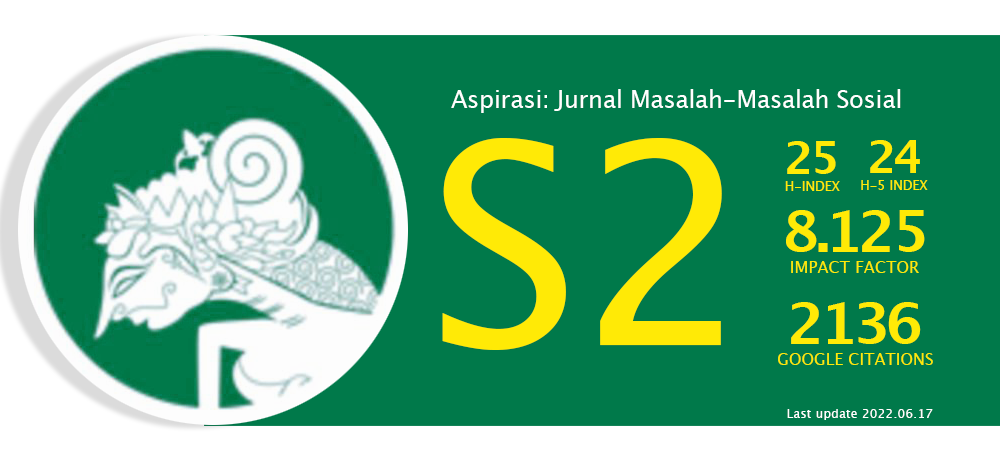DIFERENSIASI PERAN ANGGOTA KELUARGA MISKIN PERKOTAAN: PERSPEKTIF MODAL SOSIAL
Abstract
Keywords
Full Text:
UntitledReferences
Buku
-------------, 1995. Trust: The Social Values and the Creation of Prosperity. New York: Free Press.
Coleman, James. 1990. Foundations of Social Theory. Cambridge: Harvard University Press.
Evers, Hans-Dieter. 1982. Sosiologi Perkotan: Urbanisasi dan Sengketa Tanah Indonesia dan Malaysia. Jakarta: LP3ES.
Fukuyama, F., L. Omer and N. Hirst. 1997. Social Capital: The Great Disruption, the 1997 Tanner Lectures. Oxford: Brasenose College.
Gilbert, A. dan Gugler, J. 1982. Cities, Poverty, and Development: Urbanization in the Third World, Oxford.
Horton, Paul B. dan Chester L. Hunt. 1984. Sociology. USA: McGraw-Hill.
Lin, N. 2001. Social capital: A Theory of Social Structure and Action. Cambridge, Cambridge University Press, 2001,
Magnis-Suseno, Frans. 1996. Etika Jawa: Sebuah Analisa Falsafi tentang kebijaksanaan Hidup Jawa. Jakarta: PT Gramedia Pustaka Utama.
Megawangi, Ratna. 1998. Membiarkan Berbeda. Bandung: Mizan, Jakarta.
Orr, M., 1999. Black Social Capital, Lawrence, KS: University Press of Kansas.
Roberts, B.R. 1978. Cities of Peasants: The Political Economy of Urbanization in the Third World, London.
Schuler, R.T., W.W. Casady, and R.L. Raper. 2000. “Soil Compaction” in R.C. Reeder (ed.) MWPS Special Publication: Conservation Tillage Systems and Management.
Stanton-Salazar, R. A. 1997. Social Capital Framework for Understanding the Socialization of Racial Minority Children and Youths. Cambridge: Harvard Educational Press.
Szreter, S., 2000. “Social Capital, the Economy, and Education in Historical Perspective,” in Schuller, T. S. Baron, & J. Field (eds). Social Capital. Oxford: Oxford University Press.
Toennies, Ferdinand. 1957. Community and Society, translated and edited by Charles P. Loomis, East Lansing, Michigan: Michigan State University Press.
William, J. Goode. 1993. The Family. New Delhi: Prentice Hall of India Ltd.
Woolcock, M. 1998. “Social Capital and Economic Development: A Critical Review,” Theory and Society, forthcoming.
Jurnal
--------------. 1993. “The Prosperous Community: Social Capital and Public Life”. The American Prospect, 13, Spring.
---------------. 1996. “The Strange Disappearance of Civic America,” The American Prospect, 24, Winter.
Astone, N.C., Nathanson, R. Schoen, & Y. Kim. 1999. “Family Demography, Social Theory, and Investment in Social Capital,” Population and Development Review, 25 (1).
Bengtson, V., 2001. “Beyond the Nuclear Family: The Increasing Importance of Multi-Generational Bonds.” Journal of Marriage and Family, 63.
Condly, S. 2006. “Resilience in Children: A Review of Literature with Implications for Education”. Urban Education, 41 (3), 211-236.
Lent, S.A. & Figueira-McDonough, J. 2002. “Gender and poverty: Self-Esteem among Elementary School Children”. Journal of Children & Poverty, 8 (1), 5–22.
Leventhal, T., Yange, X., & Brooks-Gunn, J. 2006. “Immigrant differences in School-Age Children’s Verbal Trajectories: A look at Four Racial/Ethnic Groups”. Child Development, 77, 1359-1374.
Ostrom. 1994. “Constituting Social Capital and Collective Action”. Journal of Theoretical Politics 6 (4)
Pantoja. 1999. “Exploring the Concept of Social Capital and its Relevance for Community-based Development: The Case of Coal Mining Areas of in Orissa, India”. Social Capital Initiative WP No. 18, World Bank, Washington DC, USA.
Parcel, Toby L. & Dufur, Mikaela J. 2001. “Capital at Home and at School: Effects on Child Social Adjustment. Journal of Marriage and Family. Vol. 63, No. 1, 32–47.
Portes, A., and P. Landolt. 1998. “The Downside of Social Capital,” The American Prospect, (May-June) (26).
Putnam, Robert, 1995. “Bowling Alone: America’s Declining Social capital”. Journal of Democracy, 6:1 January.
Sanders, J. & V. Nee, 1996. “Immigrant SelfEmployment: The Family as Social Capital and the Value of Human Capital”. American Sociological Review, 61, 2.
Thompson, L., and Walker, A. J., 1989. “Gender in Families,” Journal of Marriage and the Family 51, 845–871.
DOI: https://doi.org/10.46807/aspirasi.v4i1.489
Refbacks
- There are currently no refbacks.







